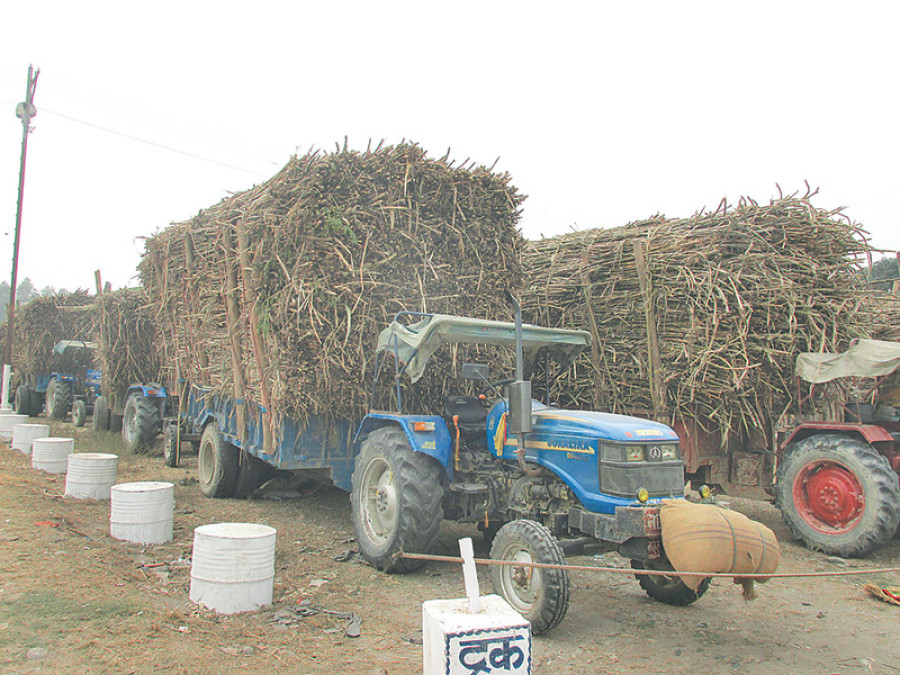Money
Province 2 sugarcane farmers defy odds
Sugarcane farms in Province 2 may have been negatively affected by the lack of labour, aging farmers, payment disputes, unfavourable climate and a delay of mechanisation, but sugarcane output has been on increasing trend.
Aman Koirala
Sugarcane farms in Province 2 may have been negatively affected by the lack of labour, aging farmers, payment disputes, unfavourable climate and a delay of mechanisation, but sugarcane output has been on increasing trend.
Even with all the problems, sugarcane is still a major crop and plays a key role that supports the livelihood of the region. Farmers here continue to expand their farms as they can reap the benefits over a long period with little labour.
Sugarcane farmers are much happier than paddy and other crop producing farmers as it requires less work, but yields more money.
The proliferation of sugar mills in the province has also given hope for cane farmers as sugar market is poised to become a multi-billion market in the near future.
Province 2 is the key sugarcane producing region in the country. The government statistics show that imports of sugar and sugarcane production have been increasing at a fast rate, especially in recent years, due to increased consumption. Sugarcane can also be used as biofuel and electricity production but it still remains untapped.
The import statistics of the Department of Customs show that Nepal imported sugar worth Rs6.72 billion in the last fiscal year 2016-17, a jump of 38 percent. If the import figure of the first six months of the current fiscal year is calculated, sugar and sugar related products might hit Rs10 billion this fiscal year.
Production of sugar in Nepal currently meets only about 50 percent of domestic demand, with the deficiency being made up with imports from India.
In many countries, sugarcane is replanted every six or seven years. In Nepal, they are often harvested up to 3 years before replanting. As the sugarcane farm requires labour for only three months a year, farmers are increasingly attracted towards the cash crop.

Jwala Prasad Pokhrel, a local cane producer in Lalbandi Municipality-2, said cane farming has been providing good income without much labour for the last four years. “In fact, we were late in expanding the sugarcane areas despite having sugar mill for many years.”
In a year, the cane farm needs labourers for only two times during plantation and harvest. The field does not need to be ploughed and is not affected by fertiliser shortage compared to other crops. Drought is the enemy for sugarcane farmers. The province has perfect soil condition for cane plantation.
Cane farming in the eastern Tarai started with the establishment of a state-owned Birgunj Sugar Factory. However, cane farmers had to suffer after the government dissolved the state-owned sugar factory in Birgunj citing lack of profit.
But proliferation of private mills has helped cane farming. Almost all mills operating here are running in profit. There are seven mills in Province No. 2. Three are located in Sarlahi, while Rautahat, Mahottari and Siraha have one each.
Sugarcane farm started growing with the establishment of Indu Shankar Sugar mill in 1986. Indu Shankar of Hariban and Annapurna of Dhankaul in Sarlahi district are in working condition. Another new mill is being constructed in Bagdaha.
Sugarcane is cultivated on 23,000 hectares in the district and farmers are expanding their farms to include better irrigation facilities.
Cane farming has improved lives of many farmers. Changes are visible in the districts. “Today sugarcane farmers have good homes, tractors and their children are studying in a good school, said Shiva Chandra Chaudhary, a farmer of Basbaria. “Cane farming has changed the economic landscape of many villages and their social lives as well.”
Provincial Assembly member Dilli Prasad Upreti said that more than 60 percent of sugar consumed in the country is produced by Province No 2. Upreti, who is also a sugarcane farmer, said that the government should create a favourable environment for farmers to get proper rates of their products.

The floor price of sugarcane has been traditionally fixed by farmers and sugar mills. The cane price is normally determined in Nepal based on the price offered by Indian mills to farmers and the provision often flares up tensions between the two sides each harvest season. Cane producers have been complaining that sugar producers take advantage of the absence of a base price by delaying fixing of cane prices. This forces farmers to sell their produce at cheaper rates.
Farmers are also forced to sell their sugarcane on credit to prevent the crops from drying up in the fields. Although sugarcane has been declared a national crop, the issue of fixing prices have become a matter of concern for farmers.
In 2015, the Cabinet had directed the Ministry of Agricultural Development to declared sugarcane “national crop” status. No crop had been declared a national crop before. Another opportunity that Nepal needs to look upon is electricity production from the sugarcane mills. Studies have shown that each mill can produce up to 5 megawatt of electricity. Upreti said that preparations are underway to connect sugarcane mills to the electrical transmission grid. “Sugar mills across the country can generate 50 megawatt of electricity.”
Besides challenges of fixing the prices annually, sugarcane farmers should be provided irrigation facilities so that productivity and production are increased.
Some farmers underscored the need for a strong organisation that can play a crucial role in ensuring a reasonable market price of sugarcane.




 10.12°C Kathmandu
10.12°C Kathmandu















